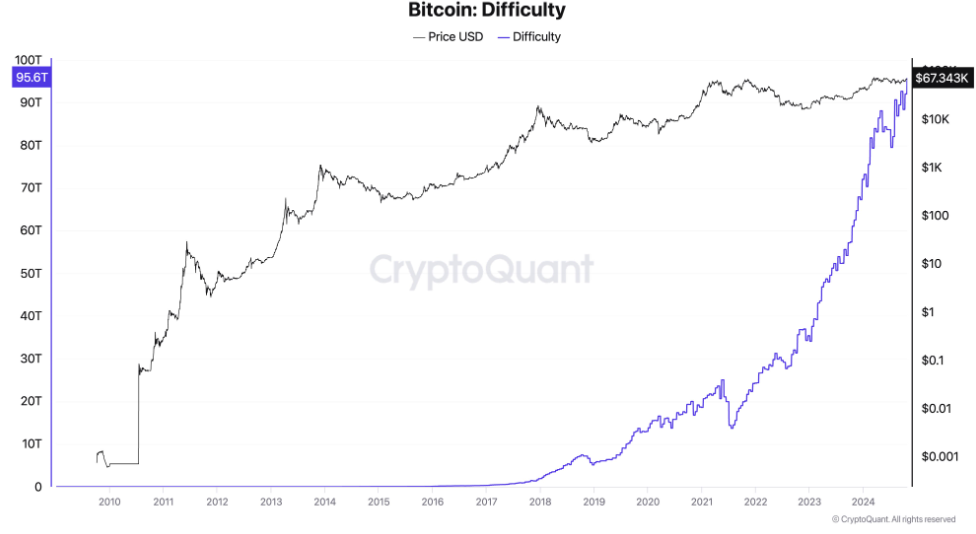According to a recent update by Ki Young Ju, CEO of CryptoQuant, Bitcoin (BTC) may finally fulfill its destiny as a global currency by 2030. Ki’s insights underline the swift development of the Bitcoin ecosystem, especially in areas such as mining and the engagement of institutional investors.
Satoshi Nakamoto, the enigmatic creator of Bitcoin, originally dreamed of it as a decentralized, peer-to-peer (P2P) electronic cash system.
CryptoQuant Founder Predicts Bitcoin’s Future as a Currency
In a post on X (formerly Twitter), Ki hinted at a future in which Bitcoin may serve as a low-volatility currency rather than merely a speculative investment. This vision stems from the transformation that Bitcoin mining has undergone since its launch in 2009.
At that time, individual miners could effortlessly mine 50 BTC using just one personal computer. Today, the landscape has changed dramatically.
Bitcoin’s mining difficulty—the measure of how hard it is to mine new blocks—has skyrocketed by an astounding 378% in just the last three years. This increase signals heightened competition in the sector, making it nearly unfeasible for individual miners to profitably participate.

As a result, the industry is now dominated by large-scale mining companies supported by institutional backers. This transition to institutional oversight has profound implications for the future of Bitcoin. With institutional investors taking charge, the barriers to mining increase, resulting in a more stable Bitcoin ecosystem.
Read More: How To Buy Bitcoin (BTC) and Everything You Need To Know
In this context, Ki Young Ju posits that this stabilization might lead to a decrease in Bitcoin’s notorious price volatility. While it could diminish its allure for day traders, it may become a more viable option as a functional currency.
The CryptoQuant CEO points to one pivotal event – Bitcoin halving. This event occurs roughly every four years, halving the reward for mining Bitcoin transactions. After the upcoming 2024 Bitcoin halving, the subsequent one is expected around April 2028.
Historically, significant price surges have followed halving events. However, Ki Young Ju envisages that the 2028 halving might signal a new chapter in Bitcoin’s development. With its volatility diminishing over time, discussions regarding its function as a “currency” might begin in earnest around that period.
Institutional Adoption of Bitcoin Set to Surge Before Next Halving
Ki Young Ju anticipates that by 2028, institutional adoption will reach a tipping point, making Bitcoin more widely accepted for day-to-day transactions. The rising presence of prominent fintech firms could contribute to Bitcoin’s metamorphosis into a currency. For example, Stripe’s recent entry into the stablecoin infrastructure sector could attract more e-commerce and global markets.
As regulatory clarity increases, stablecoins may witness substantial adoption, which would familiarize a broader audience with blockchain wallets and other cryptocurrency technologies.
Moreover, volatility has long posed a significant obstacle to Bitcoin’s usage as currency. Businesses and consumers hesitate to employ Bitcoin for transactions if its value fluctuates dramatically day by day. Yet, Ki Young Ju asserts that this volatility is gradually diminishing as the ecosystem evolves.
“As volatility decreases, Bitcoin’s role as a currency becomes increasingly inevitable,” Ju remarked.
This decline may result from improvements in protocol, Layer 2 (L2) solutions, or the uptake of Wrapped Bitcoin (WBTC). Nevertheless, Ki Young Ju notes that for Bitcoin L2s to be competitive, institutional backing will be necessary. As these enhancements are implemented, Bitcoin’s capability to function as a stable currency is strengthened.
This outlook aligns with thoughts from financial experts like billionaire investor Paul Tudor Jones, who regards Bitcoin as a safeguard against inflation and economic instability. Jones emphasizes that Bitcoin’s limited supply, particularly amid rising debt and inflation, renders it a compelling store of value.
Similarly, MicroStrategy founder Michael Saylor contends that Bitcoin’s distinct attributes make it a superior store of value over the long term. This explains the firm’s ongoing BTC acquisition strategy, which began in 2020 and is still in effect.
This increasing institutional confidence could further stabilize Bitcoin’s price, enhancing its attractiveness as a currency by decade’s end.
“We’re buying Bitcoin to hold it for 100 years. That drop from $66,000 to $16,000 weeded out the short-term investors. When Bitcoin hit $16,000, we were all prepared to see it go down to zero,” Saylor stated recently.
For Ki Young Ju, this evolution signifies a return to Bitcoin’s foundational purpose. While many classify Bitcoin as “digital gold,” Satoshi Nakamoto’s ultimate objective was for it to operate as a P2P electronic cash system.
Read more: Satoshi Nakamoto – Who is the Founder of Bitcoin?
As the ecosystem develops and volatility continues to lessen, the belief that Bitcoin cannot serve as a currency will fade. The founder of CryptoQuant is optimistic that by 2030, Bitcoin could be utilized as a practical, low-volatility currency, thus realizing Satoshi’s long-held vision.
Disclaimer
In accordance with the Trust Project guidelines, BeInCrypto is dedicated to impartial and transparent reporting. This news article aims to deliver accurate and timely information. However, readers should independently verify facts and consult with a professional before making any decisions based on this content. Please be aware that our Terms and Conditions, Privacy Policy, and Disclaimers have been revised.








